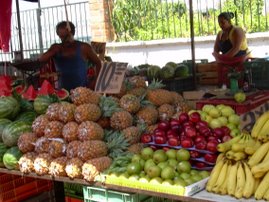 | | A post by "Frank Koughan" | http://burrohall.blogspot.com Frank is the author of Burro Hall, and is a former CBS News 60 Minutes producer who has been living in Queretaro since 2006. To see more posts by this author, click here. |
As the Iraq War enters its seventh year, I’ve been trying to imagine a world in which CIA director George Tenet, faced with deciding whether to recommend sending young American men and women into a dangerous foreign country, receives information from the State Dept. and, instead of disregarding it, accepts it as credible and recommends standing down from the mission.
As reported by the New York Times this week, this actually did happen. Unfortunately, it happened six years too late; the country was Mexico; the mission, spring break; and the young people at risk were Tenet’s college age son and his friends. And this time, it was State that was being unnecessarily alarmist.
Last month, the State Dept. issued a travel advisory for Mexico that was, by bureaucratic memo standards, rather breathless:
“Mexican drug cartels are engaged in an increasingly violent conflict - both among themselves and with Mexican security services - for control of narcotics trafficking routes along the U.S.-Mexico border…Some recent Mexican army and police confrontations with drug cartels have resembled small-unit combat, with cartels employing automatic weapons and grenades.
Large firefights have taken place in many towns and cities across Mexico but most recently in northern Mexico, including Tijuana, Chihuahua City and Ciudad Juarez. During some of these incidents, U.S. citizens have been trapped and temporarily prevented from leaving the area…The situation in northern Mexico remains fluid; the location and timing of future armed engagements cannot be predicted.”
The phrase “large fire fights” tends to have a cooling effect on the tourism trade, and sure enough, colleges across the US have started warning students against spending spring break in a “war zone.”
I have lived in Querétaro, Mexico, for two-and-a-half years. My city is about 450 miles from the nearest beach, and farther still from the nearest wet t-shirt contest, and so I don’t have any particular interest in persuading a swarm of horny teenagers to come survive for a week on tequila shooters. But America’s young people are being fed a lot of misinformation about their neighbor to the south, so I’m here to set the record straight. For the children.
There is indeed a great deal of senseless, drug-fueled violence happening in Mexico right now: over 5,000 people were killed last year, and this year the body count hit 1,000 in just 51 days. But the vast, vast majority of the dead were either involved in the drug trade themselves, or were part of the forces (Army/ police/ judges/ officials) who are fighting them. If you’re planning to spend spring break either working for a drug cartel or joining the Mexican Army, then by all means you should think twice about coming here.
Consumers of American media could easily get the impression that Mexico is a blood-soaked killing field, when in fact the bulk of the drug violence is happening near the border. (In fact, one way of putting this would be that Mexico is safe as long as you stay far, far away from the US.) If your spring break destination of choice is Juarez, Tijuana or Nuevo Laredo, I would humbly suggest that you’re both a degenerate and insane. You’ve got plenty of underage prostitutes right at home in America, and despite what you may have read there’s no such thing as a “donkey show” here. Tenet is right. Cancel your vacation or I’m giving your name to Interpol.
It’s hard to blame universities for issuing these dire warnings, since they have a responsibility to their students, and the fact of the matter is, Americans do get killed here. But in debating whether or not Mexico is dangerous, they’re asking themselves the wrong question. The issue is, is Mexico dangerous compared to the United States? We’ve been hearing for years how American kids are falling behind in math and statistics, so I’ll try to keep the following simple as I can.
According to the State Dept., 669 Americans died “non-natural deaths” in Mexico in the three years between Jan ‘05 and Dec ‘07, which accounts for 30% of “non-natural” American deaths around the world. Sounds scary, but then Mexico also accounts for 30% of the foreign trips taken by Americans, so what do you expect? Furthermore, we’re talking about 45 million American visits to Mexico, so while 669 deaths are a tragedy, they are not exactly a killing field. Based on these numbers, the survival rate for Americans in Mexico would appear to be 99.9986%
Breaking that State Dept’s numbers down a little further, though, we see that 58 percent (389) of these “non-natural deaths” were from accidents - car, plane, boat or “other.” Eighty-five Americans drowned here in this national full of beach resorts. Fifteen died of drug overdoses and 61 Americans - nine percent of the total - committed suicide! Admittedly, life here can be frustrating sometimes, but any tourist who kills himself here should, in all fairness, not be counted against Mexico total.
The number of Americans who decided Mexico would be a great place to kill themselves is nearly half the number of those who had that decision made for them. According to the State Dept, a grand total of 126 Americans were murdered in Mexico during those three years - just slightly less than the 45,000 killed north of the border during the same period. So while your chances of not dying here may be 99.9986%, your chances of not being murdered here are 99.9997%. Anyone who considers those to be dangerous odds would be advised not to spend spring break in Las Vegas, either.
Recently, the Houston Chronicle took a look at the numbers (covering four years, instead of State’s three) and came to a similar conclusion: that fewer than one-thousandth of one percent of American visitors to Mexico come back to Uncle Sam in a pine box. Actually, the way the Chronicle phrased it was, “Caught in the Chaos: More than 200 U.S. Citizens Killed in Mexico Since ‘04”.
So, y’know, one a week, which makes the country a lot safer than most US cities. But then the Chronicle goes on to note:
“The Chronicle analysis showed some American homicide victims were involved in organized crime. The dead include at least two dozen victims labeled hitmen, drug dealers, human smugglers or gang members, based on published investigators’ accusations. Others were drug users or wanted for crimes in the United States…in at least 70 other cases, U.S. citizens appear to have been killed while in Mexico for innocent reasons: visiting family, taking a vacation, or simply living or working there.”
In other words, of the “200 U.S Citizens Slain,” 130 of them simply didn’t draw their own weapons fast enough. So we’re really talking about seventy murders in four years, during which time Americans made 60 million visits to Mexico, which has a population of about 120 million. For the record, that’s ten percent fewer murders than took place in Houston, population 2 million, in the first three months of 2008:
“HPD officials say that the City of Houston has recorded the fewest numbers of murders for the first quarter of this year since 2005.
“The unofficial numbers show 78 murders were recorded through the first three months of this year.
“There were 88 murders for the same period in 2007. That’s an 11.3 percent decrease.”
In case it’s not clear, Houston officials were proud of this. And they should have been, because in 2007, Houston had the second-highest urban homicide rate in the country:
“In Houston, the number of murders increased to 379 last year from 334 in 2005, a jump officials blamed in part on hurricane evacuees.
“The homicide rate has been much higher in years past, especially the 1980s,’ HPD Capt. Dwayne Ready told the Chronicle in October.
“‘Even if the number … for 2006 hits 400 it’s not a bleak picture for Houston.’”
If 400 people get gunned down in Houston in one year, the Houston Police Dept. doesn’t think it’s a “bleak picture.” But seventy innocent Americans get killed in Mexico over the course of four years, and the former director of Central Intelligence is warning people to steer clear? Where was this sense of caution six years ago?
Mexico is a real country, kids, not some isolated beach resort. There’s crime here. People die here – mostly by accident, but some by murder. But the same is true of the United States. The state of Querétaro, where I live, is very small – a little over a million people – and at any given time there are about 50,000 Queretanos working in the United States. In 2007, forty-one of them were shipped home for burial by the Mexican embassy. Strangely, no one here ever tries to talk me out of returning home for a visit.

 Finally, I had my last English class last night. We had a party instead of a regular class. Pixie has been helping me in class, and has decided to teach a class herself next fall. Only four students showed up for the pizza party, and Pixie snapped this photo of me with these students:
Finally, I had my last English class last night. We had a party instead of a regular class. Pixie has been helping me in class, and has decided to teach a class herself next fall. Only four students showed up for the pizza party, and Pixie snapped this photo of me with these students:



















































































